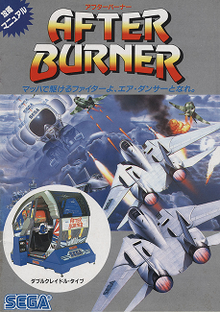
Back After Burner Catalan After Burner (Computerspiel) German After Burner Spanish After Burner Finnish After Burner (jeu vidéo) French After Burner Italian アフターバーナー (ゲーム) Japanese 애프터 버너 (시리즈) Korean After Burner LLD After Burner Dutch
| After Burner | |
|---|---|
 Japanese flyer | |
| Developer(s) | Sega AM2 |
| Publisher(s) | Sega |
| Designer(s) | Yu Suzuki |
| Programmer(s) | Satoshi Mifune |
| Composer(s) | Hiroshi Kawaguchi |
| Platform(s) |
|
| Release | July 1987 (I) September 1987 (II) |
| Genre(s) | Rail shooter[7] |
| Mode(s) | Single-player |
| Arcade system | Sega X Board |
After Burner[a] is a rail shooter arcade video game developed and released by Sega in 1987.[8][9] The player controls an American F-14 Tomcat fighter jet and must clear each of the game's eighteen unique stages by destroying incoming enemies. The plane is equipped with a machine gun and a limited supply of heat-seeking missiles. The game uses a third-person perspective, as in Sega's earlier Space Harrier (1985) and Out Run (1986). It runs on the Sega X Board arcade system which is capable of surface and sprite rotation. It is the fourth Sega game to use a hydraulic "taikan" motion simulator arcade cabinet, one that is more elaborate than their earlier "taikan" simulator games.[10] The cabinet simulates an aircraft cockpit, with flight stick controls, a chair with seatbelt, and hydraulic motion technology that moves, tilts, rolls and rotates the cockpit in sync with the on-screen action.[11]
Designed by Sega veteran Yu Suzuki and the Sega AM2 division, After Burner was intended as being Sega's first "true blockbuster" video game. Development began in December 1986, shortly after the completion of Out Run, and was kept as a closely guarded secret within the company. Suzuki was inspired by the 1986 films Top Gun and Laputa: Castle in the Sky; he originally planned for the game to have an aesthetic similar to Laputa, but instead went with a Top Gun look to make the game approachable for worldwide audiences. It was designed outside the company in a building named "Studio 128", due to Sega adopting a flextime schedule to allow for games to be worked on outside company headquarters. An updated version with the addition of throttle controls, After Burner II, was released later the same year.
After Burner was a worldwide commercial success, becoming Japan's second highest-grossing large arcade game of 1987 and overall arcade game of 1988 as well as among America's top five highest-grossing dedicated arcade games of 1988. It was acclaimed by critics for its impressive visuals, gameplay and overall presentation, and is seen as being important and influential. It was followed by a series of sequels and ports for many platforms, including the Master System, ZX Spectrum, and Famicom. Sega also produced several successors to the game to capitalize on its success, such as G-LOC: Air Battle. After Burner has also been referenced in many other Sega video games, such as Fighters Megamix, Shenmue, and Bayonetta.
- ^ Cite error: The named reference
YS23was invoked but never defined (see the help page). - ^ "After Burner (Registration Number PA0000393697)". United States Copyright Office. Retrieved 10 August 2021.
- ^ "[セガハード大百科] マスターシステム ギャラリー" [Sega Hard Encyclopedia: Master System Gallery]. Sega (in Japanese). Retrieved 6 March 2021.
- ^ Cite error: The named reference
Akagiwas invoked but never defined (see the help page). - ^ "アフターバーナー 2 ROMキット" [After Burner 2: ROM type]. Media Arts Database (in Japanese). Agency for Cultural Affairs. Retrieved 5 October 2021.
- ^ "アフターバーナー 2 シティタイプ" [After Burner 2: Sit-in type]. Media Arts Database (in Japanese). Agency for Cultural Affairs. Retrieved 5 October 2021.
- ^ Rignall, Jaz (22 January 2015). "3D Afterburner II 3DS Review: Too close for missiles, I'm switching to guns". VG247. Gamer Network. Archived from the original on 14 November 2014. Retrieved 18 February 2023.
- ^ Cite error: The named reference
KLOVwas invoked but never defined (see the help page). - ^ Cite error: The named reference
YS26was invoked but never defined (see the help page). - ^ Horowitz, Ken (6 July 2018). The Sega Arcade Revolution: A History in 62 Games. McFarland & Company. p. 131. ISBN 978-1-4766-3196-7.
After Burner was the fourth and most extravagant of Sega's taikan simulators and topping it would not be easy.
- ^ Lendino, Jamie (27 September 2020). Attract Mode: The Rise and Fall of Coin-Op Arcade Games. Steel Gear Press. p. 331.
Cite error: There are <ref group=lower-alpha> tags or {{efn}} templates on this page, but the references will not show without a {{reflist|group=lower-alpha}} template or {{notelist}} template (see the help page).